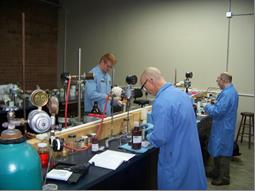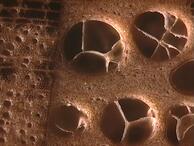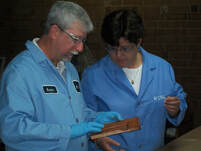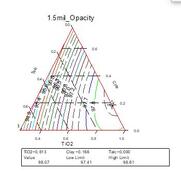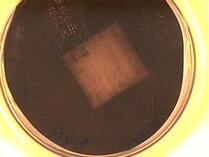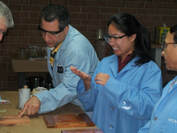SYLLABUS
|
Download Syllabus pdf
|
2024 Syllabus pdf
| |||
Practical Wood Coatings Formulation and Application Training Course
|
The Year 2024 Practical Wood Coatings Formulation and Application course is offered as both an On-Site and as a Virtual Training option. The On-Site offering is a 3 ½ -day intensive course combining lecture, laboratory instruction, and demonstration. The Virtual course offering is a 2 ½ day option designed to cover the same topics, items, and details as our On-site course, without the travel requirement. The virtual course combines lecture, video laboratory instruction and demonstration, with opportunity for interaction between instructor and participants.
|
As a whole, the course provides an overview of the wood coatings market. Further, the course introduces students to the historical aspects of wood coatings and then, systematically, brings them to the current state of the art. The course discusses solvent-based, water-based, and UV technology in a scientific, comparative and enlightening manner. The course is a comprehensive technical, marketing and idea generation resource. Participants will leave the course with improved knowledge, skills and understanding of coatings as well as a heightened sense of confidence regarding their knowledge of wood coatings. Researchers, formulators, chemists, applicators, users of wood coatings, sales, marketing and technical service personnel of raw material suppliers will find the course very beneficial. We also offer a one-half day virtual course module specifically targeted towards market managers as an overview of the wood coatings market and technology, e.g., Module 12.
Year 2024 On-Site Training Course Dates
On-Site Training Course Registration Link
Cost: $1900 per course
January 23-26, 2024
Registration Deadline: January 10, 2024
February 20-23, 2024
Registration Deadline: February 1, 2024
April 2-5, 2024
Registration Deadline: March 8, 2024
August 13-16, 2024
Registration Deadline: July 26, 2024
November 3-8, 2024
Registration Deadline: October 4, 2024
This Course is offered five times in 2024 on the above dates. On-Site classes begin on Tuesday at 1:00 PM EST and run through Friday to about 12:00 Noon EST. Registration is typically limited to 8 participants per On-Site training. Please contact us if you have individual company training needs.
Year 2024 Virtual Training Course Dates
Virtual Training Course Registration
Cost: $1700 per course
January 31 – February 2, 2024
Registration Deadline: January 19, 2024
February 28 – March 1, 2024
Registration Deadline: February 16, 2024
April 10 - 12, 2024
Registration Deadline: March 27, 2024
July 31 – August 2, 2024
Registration Deadline: July 12, 2024
October 16 – 18, 2024
Registration Deadline: September 27, 2024
November 13 – 15, 2024
Registration Deadline: October 25, 2024
This Course is offered six times in 2024 on the above dates. Virtual classes run from 8:00 AM EST to about 4:00 PM EST with breaks and lunch on days one and two; and from 8:00 AM to about 12:00 Noon on the third day.
Year 2024 Virtual Market Manager’s Training Course Dates
Virtual Market Manager’s Training Course Registration
Cost: $440 per course
January 18, 2024
Registration Deadline: January 12, 2024
February 8, 2024
Registration Deadline: January 26, 2024
March 21, 2024
Registration Deadline: March 7, 2024
May 16, 2024
Registration Deadline: May 2, 2024
October 31, 2024
Registration Deadline: October 17, 2024
December 12, 2024
Registration Deadline: November 21, 2024
This Course is offered six times in 2024 on the above dates. The Market Manager’s Training runs from 8:00 AM EST to about 12:00 Noon EST.
Module 1 - Wood Coatings, an overview of market value, characteristics, and needs
What you will learn in Module 1
What you will learn in Module 1
- Learn the potential value of the wood coatings market
- Learn the market and technical characteristics of the 8 wood coatings market segments
- Learn what new technologies are most viable and poised for impact and growth in the various markets
- Learn the primary performance requirements and characteristics of the various markets
- Learn potential required areas for research of various markets
|
Module 2 - Technology of Wood Finishing I – Wood/Substrate Properties
What you will learn in Module 2
|
|
Module 3 - Technology of Wood Finishing II – The composition of a wood finish
What you will learn in Module 3
|
|
Module 4 - Technology of Wood Finishing III – Pigmentation in coatings
What you will learn in Module 4
|
|
Module 5 - Technology of Wood Finishing IV – Specialty Finishes
What you will learn in Module 5
|
|
Module 6 - Technological Background of Solvent based and Water based Wood Coatings I – Solvent based coatings
What you will learn in Module 6
|
Module 7 - Technological Background of Solvent based and Water based Wood Coatings II – Water based coatings
What you will learn in Module 7
What you will learn in Module 7
- Combined with Module 6, strategically compare characteristics and properties of solvent based and water based coating technologies
- Learn about film formation in water based coatings and parameters necessary for film formation
- Learn about polymer-coalescent-water interactions and how considering these can lead to more successful formulations and strategies
- Learn about various polymer particle morphologies and how these impact formulation and properties
|
Module 8 - Application and Application Properties of Solvent based and Water based Coatings
What you will learn in Module 8
|
Module 9 - Reactive Polymers and Crosslinkers I – Background, Chemistry, and Reactive Crosslinkers
What you will learn in Module 9
What you will learn in Module 9
- Learn the background of crosslinked systems and network polymers
- Learn about various functional groups
- Learn how to calculate reaction stoichiometry for various functional groups
- Learn about crosslinking and film formation in aqueous coating systems
- Learn chemistry, properties, and characteristics of amino resins
- Learn chemistry, properties, and characteristics of polyurethanes
- Discover parameters that impact pot life, cure, crosslinking, appearance, and performance
Module 10 - Reactive Polymers and Crosslinkers II – Radiation Cure Technology
What you will learn in Module 10
What you will learn in Module 10
- Compare and learn the difference between UV and EB cure technology
- Learn chemistry, properties, and characteristics of UV/EB cured polymers and coatings. Discover parameters that impact and control viscosity, cure, crosslinking, appearance, and performance
- Discover relationships between photoinitiator absorbance, UV lamp spectral properties, and coating spectral properties and subsequent coating cure
- Study the influence of pigmentation on UV/EB cure technology
Module 11 - Paint Calculations
What you will learn in Module 11
What you will learn in Module 11
- Learn definitions of coating formulation constants and parameters, and learn how to calculate them
- Learn how to completely characterize a coating formulation by calculation of formulation constants such as PVC, Volume Solids, VOC, and Spreading Rate from first principles
- Learn how to calculate a coatings formula from first principles
Module 12 – Wood Coatings – Market Manager Overview
This module is targeted specifically towards market managers of raw material suppliers who may only desire an overview and may not wish to take the entire coatings training or who are not necessarily interested in technical/scientific aspects of wood coatings technology.
What you will learn in Module 12
This module is targeted specifically towards market managers of raw material suppliers who may only desire an overview and may not wish to take the entire coatings training or who are not necessarily interested in technical/scientific aspects of wood coatings technology.
What you will learn in Module 12
- Learn the potential value of the wood coatings market and identify the overall technical characteristics of the various wood coatings market segments
- Learn what new technologies are most viable and poised for impact and growth in the various markets
- Learn the primary performance requirements and characteristics of the various markets
- Gain background introduction into the make-up and composition of a coating and how coating components function within a coating
- Learn about the various operations of the finishing process
- Gain valuable insight regarding critical parameters relative to topcoat appearance and performance
- Discover the meaning of “Total System Interdependence”
Instructor – Ronald Obie
Ronald Obie is the founder of the Wood Coatings Research Group, an Independent Research and Development and Think Tank organization. Ronald has over 40 years of research, development, consulting, training, and problem solving experience in the wood coatings and coatings industry. Ronald has developed highly successful new coating technology platforms and technologies for the marketplace. He is extremely knowledgeable of the science, technology, and market characteristics of the wood coating industry. He has been a multiple short course Technology Conference instructor for FSCT / ACA in the area of wood coatings, teaching such courses as “Formulating for Factory Applied Wood Finishes” and “Crosslinking of Aqueous Wood Coatings.” Further, Ronald has taught as an Adjunct Instructor in the area of polymer chemistry. Ronald has also spoken at international and local societies, and symposia in the area of coatings science and technology.
Course language - ENGLISH
Ronald Obie is the founder of the Wood Coatings Research Group, an Independent Research and Development and Think Tank organization. Ronald has over 40 years of research, development, consulting, training, and problem solving experience in the wood coatings and coatings industry. Ronald has developed highly successful new coating technology platforms and technologies for the marketplace. He is extremely knowledgeable of the science, technology, and market characteristics of the wood coating industry. He has been a multiple short course Technology Conference instructor for FSCT / ACA in the area of wood coatings, teaching such courses as “Formulating for Factory Applied Wood Finishes” and “Crosslinking of Aqueous Wood Coatings.” Further, Ronald has taught as an Adjunct Instructor in the area of polymer chemistry. Ronald has also spoken at international and local societies, and symposia in the area of coatings science and technology.
Course language - ENGLISH

